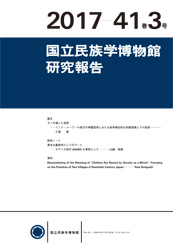Bulletin of the National Museum of Ethnology
Contents
- Articles
- Believing through Things: Corpothetic Religious Practices and the Transformation of Spirit Cults in Mewar, India
Mio, Minoru - Research Notes
- Art in Criticism of Capitalism: Case of ASARO in Oaxaca
Yamakoshi, Hidetsugu - Research Information
- Reconsidering of the Meaning of “Children Are Reared by Society as a Whole”: Focusing on the Practices of Two Villages in Twentieth Century Japan
Taniguchi, Yoko
Outline
Articles
Believing through Things: Corpothetic Religious Practices and
the Transformation of Spirit Cults in Mewar, India
Minoru Mio
Recently, religious cults centered on Sagasjī—spirits originated from exnoble Rajputs who died unfortunate deaths—have become popular among the citizens of Udaipur in western India. Lacking any sacred texts or discourse, the cults treat religious practices as crucially important, working on the images of the spirits and interacting with them through the corporeal senses.
The images of the spirits take concrete ‘Rajput-like’ form through the collaboration of followers’ imaginations about ‘Rajput-ness.’ However, they traditionally negate human individuality and the intention for spirits’ embodiment in the images, with the supreme agency being ascribed to the spirits themselves. However, at one shrine for a certain spirit, where the bulk of followers come from the urban middle class, the emphasis tends to be on the human intention for the materialization of the spirits. Moreover, that tendency is even more conspicuous as the Sagasjī appears in cyberspace.
This paper elucidates the characteristics of the religious practice of figurity, particularly that of spirit cults, considering the social relationships between the images and human beings as well as those among followers. It also explores why those characteristics have changed against the background of contemporary Indian social change.
Key Words:corpothetics, religious practice, agency of image, gentrification, cyberspace
Research Notes
Art in Criticism of Capitalism: Case of ASARO in Oaxaca
Hidetsugu Yamakoshi
This article presents the argument that activities of the street artist collective Asamblea de Artistas Revolucionarios de Oaxaca (ASARO) are not only influenced by the European Art market, but also that their art and people show a rich mutual relationship in the local context. During the anti-state government movement in Oaxaca in 2006, many artist collectives joined in accusing the state government through their art. Street art produced by ASARO artists spread into the world through the media. Soon, their street art gained popularity after being regarded as “Revolutionary Art.” However, some actors including art curators interfered with their activity. These days, ASARO is criticizing the capitalism which threatens their lifestyle and livelihood. They also imagine an alternative community called “Pueblo” in solidarity with local youth groups. This article describes the unique and vernacular relationship prevailing between their art and people.
Key Words:Art and Anthropology, Oaxaca, Street art, ASARO, Indigenous people
Research Information
Reconsidering of the Meaning of “Children Are Reared by
Society as a Whole”: Focusing on the Practices of
Two Villages in Twentieth Century Japans
Yoko Taniguchi
Recently the concept of “society as a whole rearing a child” has received attention again in Japan in the context of the nation's declining birth rate and changing values of child-rearing. This study was conducted to examine diverse ideas and the process of “rearing a child” in Japan by comparing two cases in two Japanese village societies, a fishing village (Nadara-ura) and a mountain village (Sugibayashi-mura), from the early 20th century to the 1950s. After reviewing reports of earlier studies related to both villages and some data of my fieldwork research conducted in contemporary Nadara-ura, I will present indispensable basic information related to the studies of the concept of “society as a whole rearing a child” and its change since the beginning of the 20th-century Japan.
Key Words:child-rearing, full-fledged adult concept, family, village, 20th-century Japan
 2017-Vol. 41, No. 3
2017-Vol. 41, No. 3




